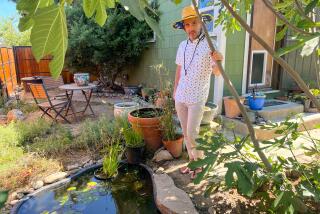Fancier Faucets Are Now on Tap
Let me tell you about the men’s john at the Madonna Inn.
It’s glorious. It’s the most wonderful public lavatory anywhere. It’s so great that women order their husbands or boyfriends or just any old guy who’s hanging around to go in and make sure the coast is clear so the women can enter and check it out with impunity. They emerge smiling and laughing and shaking their heads, and pretty soon it gets so out of hand that the men are forced out and have to use the restroom upstairs near the coffee shop.
That the Madonna Inn should be the home of Super Privy should come as no surprise to anyone who has ever had a good look at the place. The inn, in San Luis Obispo, is a kind of Mad Hatter’s castle, where there are guest rooms that look like rock grottoes and rain forests and the east side of Saturn. The dominant color is a mind-bending hot pink. The inn is a big favorite of newlyweds, who are in the initial, cavorting stage of their marriages.
It’s also the logical place for a pit stop for motorists on the Orange County-to-San Francisco run on U.S. Highway 101, being almost exactly at the halfway point. And one flight down from the coffee shop, there is blessed relief in the form of the world’s most enjoyable restroom.
It actually isn’t all that fancy, apart from the giant clam shell sinks, and it’s really sort of puny when you think about it. But along one wall is a handsome natural rock formation that appears to be a kind of rugged fountain. It is actually a trough-type urinal. When one steps close to it, an electric eye at ankle level is broken and a pump is activated that causes water to cascade down over the rocks--a flushing system worthy of the Sun King.
It is worth the wait.
But now the march of progress is about to spoil it all. Until recently, if you wanted to trigger a flow of water in a bathroom through the use of electronic gadgetry, you had to either make a banzai run to San Luis Obispo (I recommend early August) or book passage on the Space Shuttle. If you wanted water from the faucet, you did it like your grandparents did: you turned a knob.
But today, if you’re a true electronics fanatic and are willing to pay the price, you can own the ultimate in faucet fixtures for the truly lazy.
One local manufacturer, Water Facets in Costa Mesa, has come up with what is essentially a knob-less water faucet--they call it the Contempra Automatic Faucet--which is triggered by an infrared sensor.
The sensor is in front of the faucet’s aerator (where the water comes out) and is directed downward. It detects any object that passes under it when an infrared beam is reflected back to the sensor.
A signal goes to a solenoid valve, which opens and allows the water to flow out. When your hands, or your toothbrush, or your razor are pulled out from under the sensor, the valve shuts off automatically and the water is turned off. It’s also possible to get a continuous flow of water by pressing a button on the front of the faucet. The water will flow until the button is pressed a second time.
You adjust the temperature of the water by turning a single knob. This allows you to put a lid on the temperature and ensure that you’ll never get scalded accidentally.
Also, because all this stuff is electrical, it must all be hooked up to an outlet. This reveals a disadvantage in that it won’t work if there is a power failure.
But, said Hans Rindfleisch, it’ll still look arty while the juice is off. The owner of Eurobath & Tile in Costa Mesa, Rindfleisch called the faucets “incredible pieces of art, very contemporary.”
Contemporary they are. The basic bathroom faucet has stark lines and looks a bit like a shock absorber. The kitchen model is a simple gooseneck. And in each case, the overall design is remarkable because of the lack of the familiar hot-and-cold knobs.
Water Facets is not the only company making the hands-off faucets, Rindfleisch says. Delta also has a line of electric-eye models that are, Rindfleisch said, somewhat more plain and less expensive than the Water Facets line. In fact, the technology is not exactly brand new, having been used for some time in fixtures designed specifically for handicapped people. And, according to Rindfleisch, these early-generation models looked fairly sterile and institutional and had little decorative value.
Unlike the new models, they were “very sturdy and uninteresting,” Rindfleisch said.
The new generation ain’t cheap. The Delta faucet line, he said, hovers around $300. The Water Facets line tops out at around $700. The price is determined by the finish on the fixtures. All the faucets are made of solid brass and then plated with another metal--pewter, for instance--or with ceramic or other decorative materials.
The Water Facets people claim an added advantage: water conservation. They say that because the water runs only when there’s something underneath the faucet (unless you push the button for continuous flow), users can cut their water consumption up to 80%.
I wonder if they considered conservation when they installed the high-tech waterfall-in-the-loo at the Madonna Inn. Actually, it would probably save lots of water if curious visitors wouldn’t crowd into the room and keep darting back and forth in front of it and breaking the electric eye beam.
But remember that other men’s john upstairs near the coffee shop? You wouldn’t believe what’s in that one. It’s. . . .
Nah, forget it. We’re still in a drought.
More to Read
Sign up for The Wild
We’ll help you find the best places to hike, bike and run, as well as the perfect silent spots for meditation and yoga.
You may occasionally receive promotional content from the Los Angeles Times.






